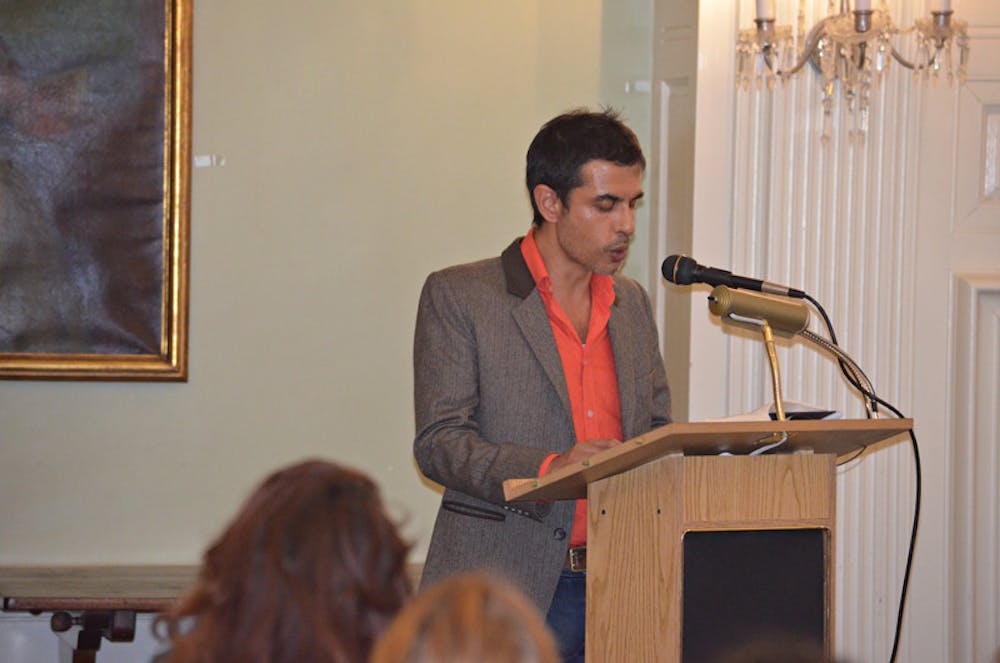It’s a question about a question: “Why is the argument about how to write about India such a contentious one?” asked Jonathan Shainin, news editor for the New Yorker, at a “Writing India: Two Authors and an Editor” discussion Tuesday night.
Shainin, previously a senior editor at the Caravan — a Delhi-based narrative journalism magazine — moderated the panel talk in Alumnae Hall, attended by about 50 students, scholars and community members.
Organized by the Brown-India Initiative, the discussion featured book presentations by Ashutosh Varshney, professor of political science and the Initiative’s director, and novelist Rana Dasgupta, distinguished visiting lecturer and writer-in-residence in the Department of Modern Culture and Media. Varshney and Dasgupta’s talks were followed by a question-and-answer session.
India’s democracy, modernization process and capitalist economic structure emerged as key topics for the speakers, who highlighted the country’s defiance of conventional wisdom about how nations develop politically and economically. India has followed a different path from many Western nations in its development, the speakers said.
Varshney’s presentation on his recently released book, “Battles Half Won: India’s Improbable Democracy,” explored how India’s democracy survives against statistical odds.
Referring to the work of the political scientist Adam Przeworski, Varshney said income is the best predictor of democracy. But India is an outlier in remaining a democracy while having extraordinarily low levels of income, Varshney said, citing Singapore as another exception to expectations. Singapore continues to have an authoritarian form of government even with high levels of income, Varshney said.
Both the “cross-cutting” of diverse languages, regions, tribes and religions within India and the country’s “unlikely” nationhood allowed India to defy the odds in becoming a democracy, Varshney said. “India is a civilization … 20 nations, not one,” he said, crediting Mahatma Gandhi, whose unifying efforts “hyphenated Indian identity” by permitting people to identify simultaneously as Indians and as part of a subgroup of the population.
“India is the longest-surviving low-income democracy in history,” Varshney said.
The key to understanding India’s democracy comes from recognizing the gap between the nation’s free elections and the corruption that occurs between elections, he added. India’s democracy is “ambivalent” — elections are a “celebration of modern citizenship” due to the plurality of Indian voters being poor or underprivileged for the past 20 years, yet the five years between elections witness a return to clientelism, when ordinary citizens lose influence over their officials’ actions.
Dasgupta offered a less analytical but more descriptive approach to India. Reading two passages from his upcoming book, “Capital: The Eruption of Delhi,” Dasgupta presented a detailed look at the contrast between ultra-rich residents of Delhi — who often can afford to have property outside the city — and the city’s low-income inhabitants.
Calling the business elite the “agents of new India,” Dasgupta spotlighted the high level of wealth accumulated by the nation’s top income earners amid fast economic growth, while others make their beds on the streets of Delhi.
Audience members expressed interest in the speakers’ books and focus on the nuances of India’s politics and economy.
“I think that Dasgupta’s book is exemplary,” said Emilio Leanza ’15. “I think there’s a tendency of thinking the Indian robber barons are particularly vile, but what Rana (Dasgupta) presented today is … why are these billionaires any less culpable than those in the U.S?”
“I really liked Dasgupta’s talk on corruption,” said Uday Agrawal ’15. Clientelism in India is “a unique problem in India for India,” which is hard to compare to political corruption in the United States, he added.
Looking at India through both a local lens and a global lens is necessary, Dasgupta said. While Indian capitalism cannot be entirely explained using other nations’ historical trajectories, observers must also look at the global dimensions of India’s development, he said. There is “turmoil” in India, but that is “capitalism as usual,” he said, disputing the vilification of the rapidly growing country’s super-rich.
Comparisons of today’s India to Gilded Age America bring many questions, such as whether the American past can help predict India’s future, the speakers said.
Citing the “irreproducible” American history through the late 19th and early 20th century, Dasgupta said the two countries’ political-economic development patterns cannot be accurately compared.
“The rich of India can finance campaigns, but they can’t win them,” Varshney said, drawing a contrast with Gilded Age industrialists who held political sway in the United States. The “instincts” of Indian businessmen are blocked by the high turnout rate of the nation’s low-income citizens in elections, he said.
India represents “capitalism of the future,” Shainin said.

ADVERTISEMENT




